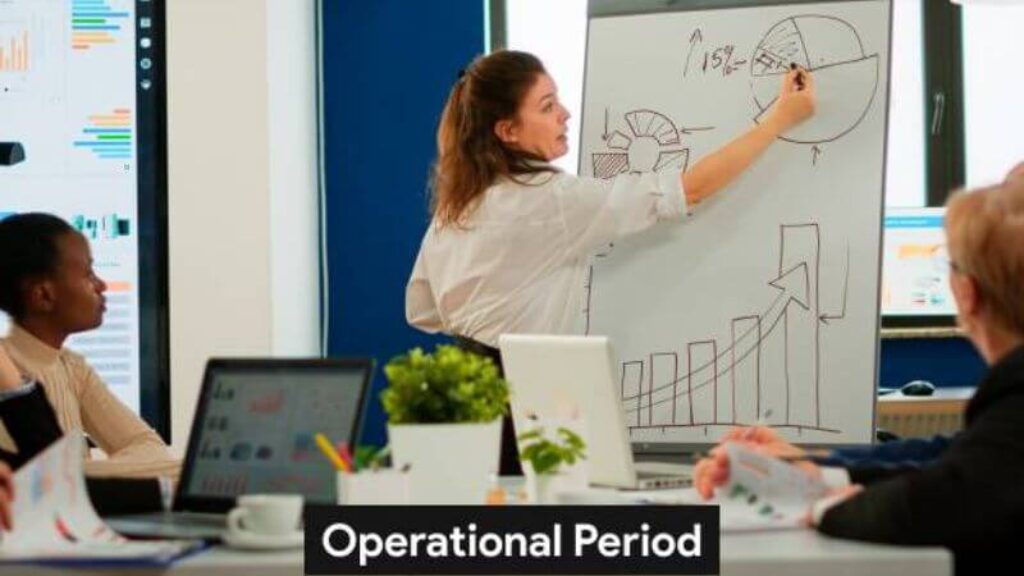From event planning and emergency operations plans to military functions and other several fields, an operational period briefing is imperative to ensure maximum efficiency and seamless task execution. However, understanding ‘Which of the following best describes the operational period briefing is one crucial component of effective operation.
Keeping that in mind, we have extracted absolute details of an operational period briefing.
In this post, you will gather enough knowledge about the operational period briefing and related info about this phrase.
Let’s dive into the gory details of this term and understand which of the following best describes the operational period briefing.
But first, let’s begin with its definition, Let’s roll in!
What Is an Operational Period Briefing?

Operational period briefing also known as operational briefing is a period prior to each operational period. Simply put, it is a meeting that unites all the supervisory personnel and other team members to discuss and carve out a strategy for the next operations. It is conducted before the beginning of any operations.
It is a crucial tool that is used in emergency response and management. An operational period briefing serves as a key plan to share info, coordinate action, and mobilize resources during a crisis.
This term also represents an IAP (Incident Action Plan) for every supervisor or resource overseer. This briefing is designed for only these personnel before starting any operation.
The operational briefing period or OPB includes the objectives, timelines, and needed resources. When an operational period briefing is conducted, supervisors or resource overseers can formulate a plan to handle and manage any specific issue.
An OPB aids resource supervisors or overseers in handling unexpected or immediate challenges in an incident. This ensures seamless workflow and quick management of the issue during various incident operations.
An OPB typically includes:
- Current and expected dangers.
- Assignment and responsibilities.
- Safety considerations.
- Incident strategies and objectives.
- Allocation of resources.
- Weather and environmental conditions.
- Public information and community relations.
What is the Purpose of Operational Period Briefing?

Now you know what operational period briefing is, let us understand what is the key purpose of OPB.
So, the main objective of an operational period briefing is to ensure that all the team members are working on the same page synchronized during an incident. Each person knows what, where, of incidents or happenings.
When an incident expands, a clear OPB gives straightforward objectives and priorities of the situation to ensure that each personnel can work towards accomplishing them.
Here is the list of key purposes of an operational period briefing:
Goal Setting
In an OPB, the overall objectives and specific goals are determined and established. This enables all team members to understand the expected results and align their actions and efforts according to that.
Circulation of Information
The most important purpose of an operational period briefing is that all the resource overseers, supervisors, and relevant personnel have up-to-date and clear information about their tasks, objectives, and the operational timeline. This includes the sharing of crucial information such as resources, situations, constraints, and alterations in the plan.
Identification and Mitigation of Risks
In an OPB, all the potential risks, challenges, and hazards are thoroughly analyzed and discussed. Each team member can identify and evaluate potential threats that can impact the success of an operational period. This way they can formulate effective strategies and plans to mitigate all such risks.
Assignment of Tasks
An operational period brief eases the process of assignment of duties and responsibilities to relevant teams and personnel. This ensures that each member of the team is clear about their
duties, priorities, and timeline of a task. It avoids duplication of work and promotes effective coordination.
Collaboration and Coordination
An OPB promotes coordination, collaboration, and communication among different teams and units that are part of an operation. This can create a channel for requesting assistance, sharing updates, and nurturing an integrated approach.
Who Facilitates the Operational Period Briefing? Who Are the Participants of an OPB?

An operational period briefing is facilitated by an incident commander or a designated command staff. Command staff includes personnel in operations, finance, planning, logistics, and public information positions. Incident objectives that drive incident operations are established by the commander. This person ensures that the implementation of the program is effective.
The incident commander directly works with the executive team and supervises the entire team in the incident. He/she serves as a link between different departments and ensures the seamlessness in the operation.
This operational period briefing is a meeting that a command staff organizes. An OPB helps the team learn about their roles and responsibilities during the upcoming period and prepare their action accordingly.
People who are participants in an operational period briefing are:
- The Incident Commander.
- The Planning Section Chief.
- Operation Section Chief.
- The Safety Officer.
- Logistic Section Chief.
- The Administration and Finance Section Chief.
- The Liaison Officer.
- The Public Information Officer.
- Particular support teams such as the medical unit and communication unit.
Significance of Operational Period Briefing
An important feature of emergency operation plans is that it helps responders in:
- Learning to monitor all the activities and performances of staff working as their subordinates.
- Developing tactical knowledge of managing all the complex emergencies and incidents.
- Presenting the IAP for the next period that includes medical units, communication, and supporting units.
- Preparing for unforeseen emergencies.
- Handling all the safety precautions.
What is the Operational Period Briefing Cycle?

The operational period briefing cycle is a process of incidents that develop the IAP for the upcoming operational period. Here is the complete OPB cycle:
Review of Briefing
The Planning Section Chief facilitates the briefing and the review. He/she makes sure that all involved individuals are prepared with their presentations. The Planning Section Chief ensures that all the aspects of the OPB are addressed. He/she is responsible for ensuring that all crucial info is shared with the participants and that the entire briefing period runs seamlessly.
Presentation of Incident Objectives
The Incident Manager or Incident Commander takes care of the incident objectives. His/her responsibilities include managing all incident operations, developing incident objectives, allocating resources, and supervising all the individuals involved in a particular incident. The Incident Commander is the main point of contact for any incident.
Assessment of Current Situations
The Operations Section Chief manages incident operations and generally works in the operations functional area. He/she directly reports to the Incident Commander. His/her main responsibilities include creating and directing divisions, branches, and units to support different operations. The OSC handles the establishment and execution of complex assignments in the incident action plan.
Considerations Affecting Response
Technical Specialists provide technical assistance like troubleshooting software and hardware issues and solving customer service queries. He/she takes care of analyzing and designing network solutions.
Review of Specific Risks
The Safety Officer or Occupational Health and Safety officer reports to the Chief Operations Officer. He/she provides monitoring, advising, management, and reporting in the department. His/her responsibility includes ensuring security in the workplace.
Development of Resource Order
Logistic Section Chief provides support like services, facilities, and materials in an incident. They offer support such as communications, supplies, transportation, food and medical services, equipment maintenance, and fueling during an incident.
Financial Updates
The Administration and Finance Section Chief provides financial updates and supervises the members of the Administrative Section as well. He/she is responsible for the cost analysis of incident financial and administrative aspects and reports to the Incident Commander. Additionally, they oversee sales force performance evaluation to ensure efficient operations.
Information Issues Discussion
The Public Information Officer discusses information issues and shares timely info about their organization with public members. He/she regularly communicates with the outside community as an ambassador of the organization.
The responsibilities of a public information officer include answering questions in public and capturing information, hosting special events, and doing press releases to promote important events and holidays.
He/she also arranges meetings across the stakeholders and their organizations. Building healthy and strengthened relationships with the media, strategizing content for updates, and supporting management to create a good image of the organization are other responsibilities of a Public Information Officer.
Identifying Interagency Issues
The Liaison Officer identifies and discusses interagency issues. This person communicates and coordinates activities between two or more organizations on mutual aid. He/she is responsible for maintaining beneficial relationships between organizations.
Closing Remark & Announcements
The Incident Commander restates concerns related to operations and employs resources accordingly. The Planning Section Chief announces the operational period briefing and the next planning meeting. After that, he/she adjourns the meeting.
What is the Best Approach to Conduct an Operational Period Briefing?

The following elements should be kept in check to conduct an effective operational period briefing:
Visual Support and other Materials
The use of charts, maps, or other multimedia presentations can increase engagement and understanding during an OPB. Other helping materials such as reference docs or clearly written instructions can be disseminated among participants for more clarification and future reference.
Clear Communication
The briefing should be done as clearly as possible. It should not have any complex technical terms or jargon that confuse the participants during the briefing. Sharing information in a structured manner makes sure that all the participants are engaged and understand the key points in a briefing.
Adaptability and Flexibility
A well-executed operational period briefing should be flexible and can easily accommodate unforeseen changes or developments in a plan. All the adjustments and updates should be shared with all participants promptly, so they can adapt quickly and change their plans accordingly.
Active Involvement and Feedback
Questions and feedback from all the participants should be welcomed. This ensures the active involvement of all the participants and ensures that each one of the team members understands their roles and responsibilities correctly. This also creates a channel for an open dialogue where more clarification and issue redressal is done immediately.
Frequently Asked Questions on Operational Period Briefing Cycle
What is ICS?
ICS stands for the incident command system. According to the NIMS, the incident command system is a combination of equipment, personnel, facilities, procedures, and communications operating which are designed to help in resource management during an incident response.
Which of the following best describes the operational period briefing?
Operations period briefing is best described as the IAP for the upcoming period to control personnel involved in an operation.
What is the length of the operational period briefing?
Although the length of an OPB depends on the complexity of the crisis and the number of team members in attendance, usually it last between 1 to 2 hours.
Why is an operational period briefing important?
An OPB is important to accomplish common goals via coordinated efforts and response among different incident responding agencies and personnel.
Who generally facilitates the operational period brief?
An operational period briefing is facilitated by an incident commander or a designated command staff. Command staff includes personnel in operations, finance, planning, logistics, and public information positions.
What is included in an operational period briefing?
An operational period briefing includes critical information, the current situation, allocation of resources, plan priorities, assignments, etc.
What is the main purpose of an operational period briefing?
The main purpose of an operational period briefing is to share critical information, allocate resources, and coordinate actions among responders during a crisis.
What are the best practices for conducting an operational period briefing?
A well-executed OPB should include visual aids, be flexible, and adaptable, encourage the active involvement of participants, and be clearly communicated.
The Closure: Operational Period Briefing
The operational period briefing is a crucial component used in emergency response and management. A well-executed OPB promotes an understanding of the incident goals and ensures effective communication and coordination between incident responders. It helps personnel to identify challenges and address them effectively. In other words, OPB is a key factor in deciding the outcome of an operation or a mission.
By now, you must have got answers to all related questions to OPB, including which of the following best describes the operational period briefing.
We hope you found this post helpful. Please provide your valuable feedback as it matters to us a lot!











